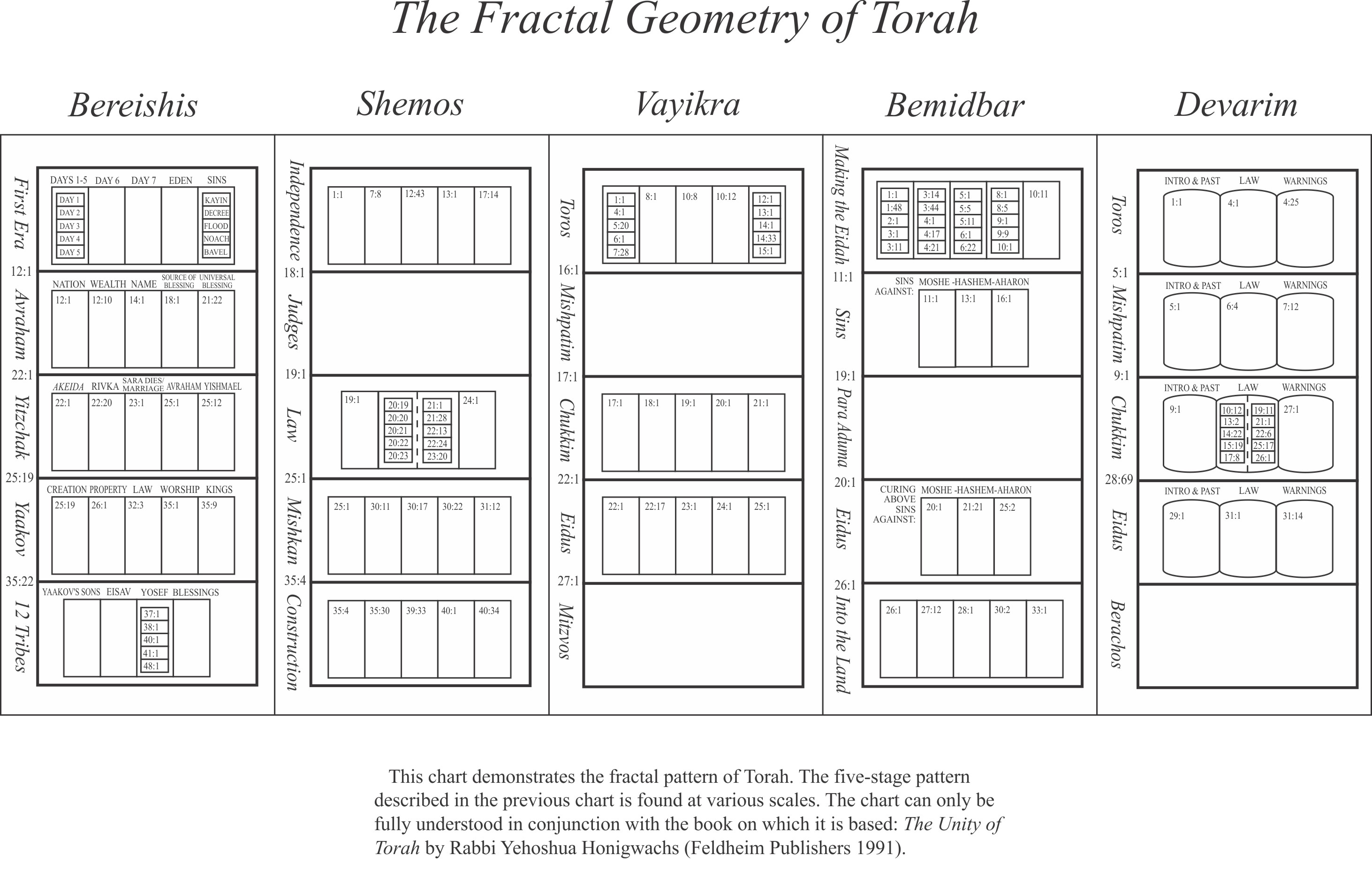I was therefore thrilled when, at that time, I came across an obscure and difficult book by Rabbi Yehoshua Honigwachs called The Unity of Torah. This work set out to answer a question that, to my astonishment, nobody had ever asked before: What is the overall structure of the Torah? Rabbi Honigwach's answer was that the structure of Torah reflects a five-stage approach to its central goal: Taking man from the extremes of egotism, in which society is an anarchy of selfish elements, towards a state of unity between all men and God. This pattern, argued Rabbi Honigwachs, is found in each of the five commandments on the Tablets of Law; it is also found amongst the five books of the Torah; within these books; within each fifth of these books; and so on - although, he noted, there are some places where a different version of this pattern is found, and there are others where it is not found at all. (There is a new book, Patterns on Parchment - The Structural Unity of The Five Books of Moses by Dr. Robert Appleson, which is an expansion of Rabbi Honigwachs' book, but I haven't read it.)
Needless to say, I was very much taken with this fractal pattern. I figured out a way to diagrammatically illustrate it in ways that made it easier to comprehend; I sent my illustrations to Rabbi Honigwachs, who was pleased at the result. In my book The Science of Torah, I made much use of fractal patterns, and I decided to include an overview of Rabbi Honigwach's approach in an appendix. You can freely download the appendix at this link, and it is also aided with the following schematic:
But my mentor Rabbi Aryeh Carmell was very unhappy with my interest in such patterns, being skeptical of this sort of pattern-seeking in general. I, on the other hand, was obsessed with it! We worked out a compromise, whereby I clearly restricted such discussions to distinct parts of the book, and he made it clear in his approbation that he was not supportive of those parts.
Today, I realize that pattern-seeking is both one of man's greatest strengths and one of his greatest weaknesses. In evolutionary terms, it was a helpful skill to learn; it enabled man to spot a camouflaged predator, and to discover causal relationships in the natural world. But, as a result, people also have a powerful propensity to see patterns even when none exist, and to ascribe causality even where there is none (as in much religion, and alternative medicine). And the thrill of discovering patterns can easily hamper one's objectivity. Of course, there are also those who deny patterns and causality even where they really exist (such as liberals with regard to Islamism, and smokers with regard to the dangers of smoking); but the former problem seems more innate and pervasive.
So what about this fractal pattern in the Torah? I don't have the time, or the objectivity, to study it all again and re-evaluate it. For a variety of reasons, I am certainly inclined to be skeptical. Nevertheless, I remain impressed at how Rabbi Honigwachs freely admitted that his pattern does not work in all places, which indicates a high degree of objectivity, and presented it as a model to be further refined. I was also interested to discover an article in Jewish Bible Quarterly that also discusses it.
Furthermore, with regard to the more limited suggestion of the pattern appearing in the two tablets of the Ten Commandments, it appears much more straightforward. As I noted in The Challenge Of Creation, a similar structure has been observed in the Six Days of Creation by scholars from across the theological spectrum. There is even more reason to expect it in the Ten Commandments, which from the outset are presented in two parts. I present an illustration of this pattern here (I hope it displays properly in different web browsers). Chag sameach!
Beginning with: Selfishness; Isolation; Focus on the Individual
TABLET #1
Manifestation between Man and God
|
DEVELOPMENT
|
TABLET #2
Manifestation between Man and Man
|
Accepting God
Acceptance of God’s existence
|
STAGE ONE
Acceptance of others’ existence
|
Do Not Murder
Other people’s right to exist; Value of life
|
Do Not Worship Idols
Accepting God’s ownership of the entire universe
|
STAGE TWO
Acceptance of their domain
|
Do Not Commit Adultery
Accepting the other person’s domain
|
Do Not Take God’s Name in Vain
No unlawful use of God’s Name
|
STAGE THREE
No unlawful use of property
(lawful coexistence) |
Do Not Steal (Kidnap)
No unlawful use of another’s being, person or property
|
Observing Shabbos
Testifying to God’s authority
|
STAGE FOUR
Readiness to cooperate
(particularly through speech) |
Do Not Testify Falsely
No destructive talk; hence, cooperate
|
Honoring Parents
Unity with one’s source
|
STAGE FIVE
Total unity
|
Do Not Covet
No resentment of others
|
Climaxing with: Selflessness; Unity with God and man; Integration into the Community























